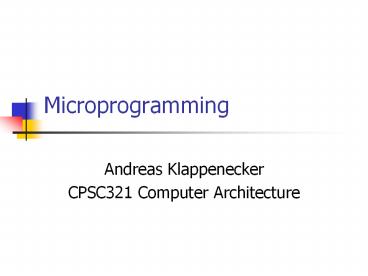Microprogramming - PowerPoint PPT Presentation
Title:
Microprogramming
Description:
Implementation (off-chip ROM) Advantages. Easy to change since values are in memory ... ROM is no longer faster than RAM. No need to go back and make changes ... – PowerPoint PPT presentation
Number of Views:709
Avg rating:3.0/5.0
Title: Microprogramming
1
Microprogramming
- Andreas Klappenecker
- CPSC321 Computer Architecture
2
Implementation of the Finite State Machine
Control Logic
3
Graphical Specification of FSM
How many state bits are needed?
4
Two-Level Logic
- Any logic function can be written in a two-level
- representation, e.g. the sums-of-products form
- E AB C AC B BC A
- It uses the logical OR of products (AND ops)
- Contains variable or complemented variable
5
PLA Implementation
- Two level logic
6
Finite State Machine for Control
- Implementation
7
Microprogramming
8
Motivation
- The full MIPS instruction set contains over 100
instructions - Instructions can take from 1 clock cycle to more
than 20 clock cycles - Pipelining will lead to explosion of states
- It follows that the control will be quite complex
gt FSM can be cumbersome - Use microprogramming!
9
Microprogramming
- Implementation of MIPS instructions as a sequence
of simpler instructions - Design of the microinstruction format
- Write a program
- Eases implementations of pipelined processor
10
Micro-Instructions
- What is needed?
- ALU control signals
- Program counter control signals
- Complete data path
- What do we do?
- Analyze what is happening at each step
- Express in a column oriented way
- Translate it into binary
- Store it in an appropriate form
11
A Simple Implementation
12
(No Transcript)
13
Microprogram
- Physical implementation ROM or PLA
- Each micro-instruction has an address
- Sequentially ordered
- Each sequence step is one cycle
- Selection of next instruction
- Address increment (sequencing field seq)
- Fetch begins fetching the next micro-instruction
(sequencing field fetch) - Dispatch jump to the next micro-instruction, the
number i indicates the location in the dispatch
table
14
(No Transcript)
15
Microinstruction format
16
(No Transcript)
17
(No Transcript)
18
(No Transcript)
19
(No Transcript)
20
(No Transcript)
21
(No Transcript)
22
(No Transcript)
23
(No Transcript)
24
(No Transcript)
25
(No Transcript)
26
(No Transcript)
27
(No Transcript)
28
(No Transcript)
29
(No Transcript)
30
(No Transcript)
31
(No Transcript)
32
(No Transcript)
33
Microcode Trade-offs
- Specification Advantages
- Easy to design and write
- Design architecture and microcode in parallel
- Implementation (off-chip ROM) Advantages
- Easy to change since values are in memory
- Can emulate other architectures
- Can make use of internal registers
- Implementation Disadvantages SLOWER
- Control is implemented on same chip as processor
- ROM is no longer faster than RAM
- No need to go back and make changes































